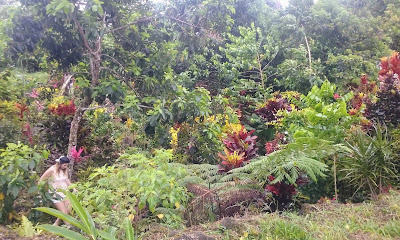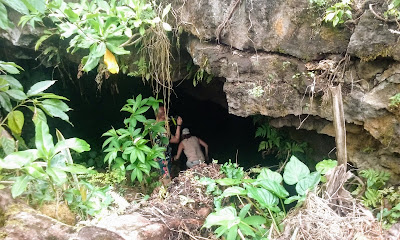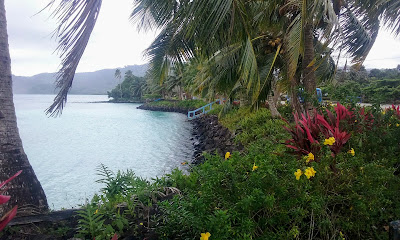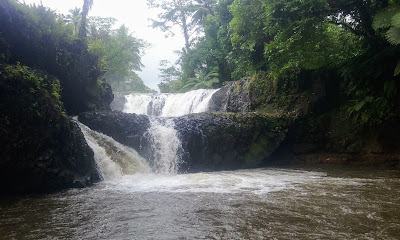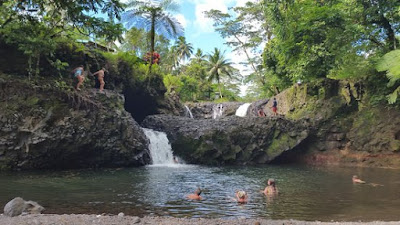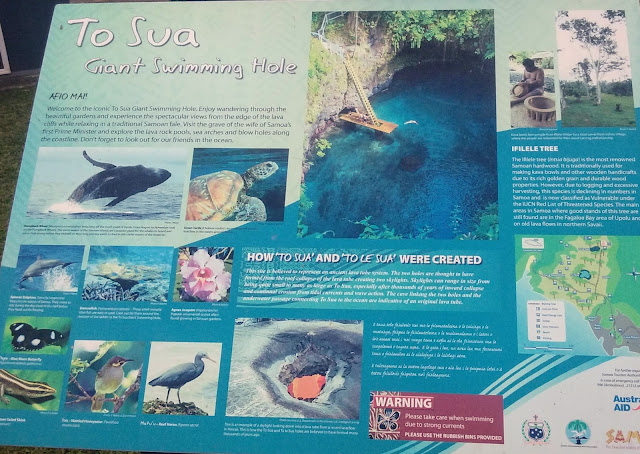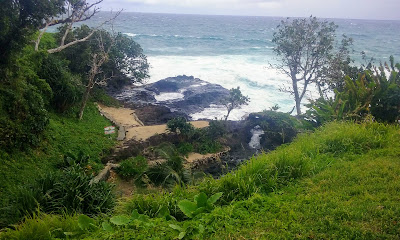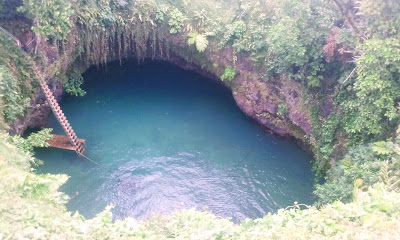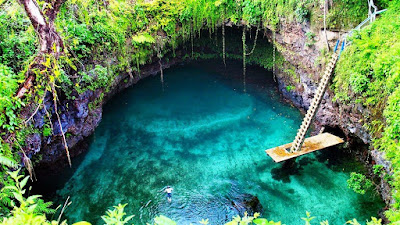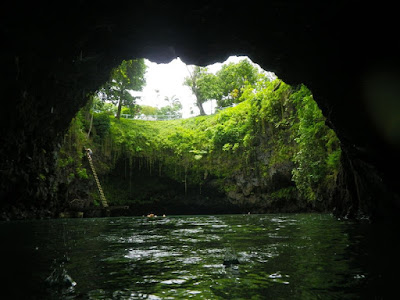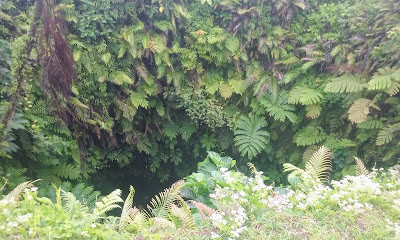On day three, we intended to hop on and off the bus to visit a variety of landmarks around Upolu. We had both done quite a bit of research on the Samoan buses and understood that they make a constant loop around the (basically circular) island, and there is no predicting when they will come, but if you hang out by the main road long enough, you can flag one down. Alright, simple enough. Well, when we told our Matareva hostess of our plans, she was horrified, saying we’d have to take at least three different buses in order to get to just the first of our several stops. Then she explained the we could sign up for their “Adventure Tour” which went everywhere we wanted to go, plus a lava tube. This was the first of many experiences we had in Samoa when someone seemed extremely helpful and knowledgeable about a system that didn’t made sense to us, but also their suggestions benefited them, so we while we wanted to trust them, it was hard to be certain. (The longer we spent in Samoa the more convinced we were that these people were too nice to mislead us, and I continue to believe/hope that that’s true.) In this case, the price for the tour was very reasonable, and fighting with multitudes of unpredictable buses sounded awful, so we decided to do it. And we’re so glad we did, because the tour was definitely a highlight of our trip, in ways that doing those things on our own, even if the bus plan had worked perfectly, would not have been.

We got in the van in the morning with a group of strangers, who by the end of the day felt like friends. We were accompanied by a man and two boys (perhaps 12 and 16) who were members of the family who owned Matareva Beach Fales. We assumed that the man was our tour guide, but soon found out that he didn’t speak English, and the two boys would be showing us around. They were hilarious and enthusiastic tour guides, with unorthodox but very entertaining methods, and I’m so glad we spent the day with them!
First we walked through some amazing native bush, with all kinds of incredible flora…
… to arrive at a lava tube. Our tour guides told us that it’s not on any websites or maps, but they’d like to make it more well-known in conjunction with their fales. It was too dark inside for pictures, but it was amazing in there, although extremely hot and humid (so much so that you could see the water in the air in the flashlight beams). There was also condensation on the walls, and when it beaded up on top of some kinds of lichen it glittered like gold. Our tour guides explained that people would shelter in these tubes (which are miles long) if there was a natural disaster, and showed us a grave deep inside it. They didn’t know the story of who the person was, but you can imagine hard times.
Next, we headed to Savaia, where there is a Giant Clam Sanctuary.
Having no underwater photo-taking ability, I am reduced to internet photos, but I can assure you that this is exactly what these clams looked like! Unbelievable, right? They are amazing! The ones that colour were mostly about 120cm (47in or almost 4 feet) long. And we learned that if you drop a rock on it, it will shut on it, then jettison it out with a jet of water! Click
here for an underwater video around the sanctuary (apologies for the annoying music) and
here for more information about endangered Giant Clams.

Also, bonus – sea turtles live there too! Unfortunately Maria and I were not together when another tourist pointed one out to me, so she didn’t get to see it, but I swam near it for several minutes, and it was amazing! There are places in Samoa that specifically advertise swimming with sea turtles, but they had mixed reviews on how happy the turtles were about coming into a confined space with people, so we decided not to go. But meeting this one in its natural habitat was so special!
Next, we headed to Togitogiga Waterfall.
(A note before I continue: In order for Anglophones to pronounce the Samoan ‘g’, it’s helpful to imagine that it has an ‘n’ in front of it, as it sounds much like the end of ‘ing’. So this waterfall is pronounced as if it was spelled Tongitonginga. I find this very cook, because keeping it in mind as I read Samoan made me much more able to find overlap between it and Māori.)
This beautiful waterfall was not only visually stunning but very adventurous (as promised by the tour name). We spent a little while swimming around the freezing water at the bottom (a welcome change from the heat of the day at first, but really too cold for extended enjoyment) and challenging ourselves to swim against the current to get near the bottom of the falls.
Then Walter, the younger of our tour guides, showed us how to climb up the side of the falls and where to jump into the pool. (This is a stock photo, as we were much too busy adventuring to take any.) On the left, you can see people jumping from one place we jumped from, but above them you can also see a little fence – we also climbed up and jumped from there. It was much more exhilarating, because you had to make sure to jump as far out as possible to make sure you cleared the lower ledge. It was not physically challenging to do so, but added an extra sense of adventure.
Our last stop of the day was to To Sua Giant Swimming Hole. Rather than regurgitating the information from this information panel, I thought I’d just include it – if you click on it, it should get big enough that you can read the words.
The whole area surrounding the swimming holes was very beautiful, although we explored very little. If we read the map right, this is the area where the lava tube connected to the swimming hole joins the ocean. Plus, look at that lovely little pool in the middle of the volcanic rock. Stunning.
This is the picture we took of the more open side of the lava tube. It was a bit overcast when we were there, for which we were very thankful, as it kept the temperature at a manageable 30C (86F), but it did mean that the colours of the water were a bit muted. It might also have kept some tourists away, because we were extremely lucky to find it mostly empty and ready for our exploration, whereas I’ve heard it can be quite busy.
Just for comparison’s sake, however, here is a photo of what it looks like under full sun.
This is looking back from the smaller of the two places where the roof of the lava tube collapsed. It was pretty exciting to swim through the tube part – I have a rather irrational fear of dark water, so I did take a deep breath or two before striking out into the tunnel, but it was worth it, and unsurprisingly, no sea monsters attacked me at all! Plus the view was amazing! So that’s a win for adventure.
This is looking down at that smaller pool from on top. I wish I could find a picture of looking up out of it, because seeing the light filtering down through all that lush greenery (and especially the ferns) was really special.

As I mentioned, the lava tube is connected to the ocean by an underwater section, so as the waves/tides roll in/out an enormously powerful suction is created. This causes an intense current within the swimming hole that changes direction rapidly every minute or so. There are ropes strung across the main section, and then one that you can pull yourself along to go through the tunnel. There is just enough of a threat in the idea of getting sucked into the underwater tube to get your adrenaline pumping, and this combined with the acrobatic potential of an underwater rope and a conveniently placed submerged rock results in some amazing playfulness, even in adults. By this time we had bonded with our fellow tourists and were ready to join together in all kinds of shenanigans and comfortable laughing with/at each other. This last bit was important, as we tested the limits of how far we could stray from the rope, how high we could balance on the rock, or which body parts we could link to the rope before the indomitable water inevitably returned us to our tightfisted grip on the lifeline. I think we all felt that we could do it forever and never get bored, but also realized fairly quickly that it was fatigue, not boredom, that would limit our adventures. What a workout! Walter again led the way in jumping from crazy heights (the exhilarating of the jump replaced immediately by the driving need to find the rope as soon as you hit the water), and then after that, we retreated to the car, exhausted but satisfied. Both of our young tour guides collapsed into the front seat in exhaustion, and were fast asleep by the time we got back to the fales. They’d made us laugh all day and shown us a truly amazing adventurous side to Samoa, and they deserved their rest.
The combination of adorable and entertaining guides, incredible sights, fantastic company, and invigorating adventure made this a day we will never forget!
 The authors reflect on three risk communication themes related to the pandemic: trust, tradeoffs, and preparedness. Trust is critically important during such a rapidly evolving event characterized by scientific uncertainty. Reflections focus on uncertainty communication, transparency, and long-term implications for trust in government and science. On tradeoffs, the positive and unintended negative effects of three key risk communication messages are considered (1) stay at home, (2) some groups are at higher risk, and (3) daily infections and deaths.
The authors reflect on three risk communication themes related to the pandemic: trust, tradeoffs, and preparedness. Trust is critically important during such a rapidly evolving event characterized by scientific uncertainty. Reflections focus on uncertainty communication, transparency, and long-term implications for trust in government and science. On tradeoffs, the positive and unintended negative effects of three key risk communication messages are considered (1) stay at home, (2) some groups are at higher risk, and (3) daily infections and deaths. The authors argue that greater attention to message ‘tradeoffs’ over ‘effectiveness’ and ‘evaluation’ over ‘intuition’ would help guide risk communicators under pressure. On preparedness, past infectious disease outbreak recommendations are examined. Although COVID-19 was inevitably ‘unexpected’, important preparedness actions were largely overlooked such as building key risk communication capacities.
The authors argue that greater attention to message ‘tradeoffs’ over ‘effectiveness’ and ‘evaluation’ over ‘intuition’ would help guide risk communicators under pressure. On preparedness, past infectious disease outbreak recommendations are examined. Although COVID-19 was inevitably ‘unexpected’, important preparedness actions were largely overlooked such as building key risk communication capacities.








